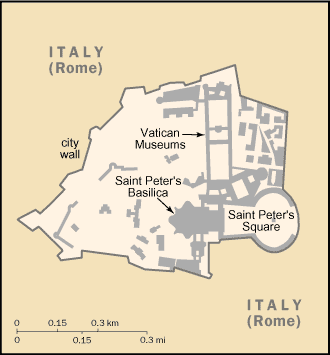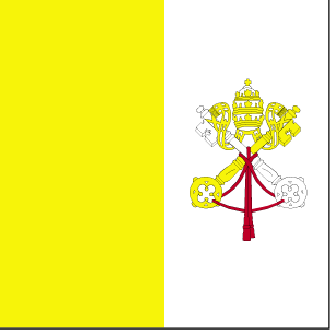
|
Holy See (Vatican)
Background:
Popes in their secular role ruled portions of the Italian peninsula for more
than a thousand years until the mid 19th century, when many of the Papal States
were seized by the newly united Kingdom of Italy. In 1870, the pope's holdings
were further circumscribed when Rome itself was annexed. Disputes between a
series of "prisoner" popes and Italy were resolved in 1929 by three Lateran
Treaties, which established the independent state of Vatican City and granted
Roman Catholicism special status in Italy. In 1984, a concordat between the
Holy See and Italy modified certain of the earlier treaty provisions, including
the primacy of Roman Catholicism as the Italian state religion.
Location:
Location: Southern Europe, an enclave of Rome (Italy).
Area: Total: 0.44 sq km.
Area - comparative: About 0.7 times the size of The Mall in Washington, DC.
Land boundaries: Total: 3.2 km, border countries: Italy 3.2 km.
Climate and Terrain:
Climate: Temperate; mild, rainy winters (September to mid-May) with hot, dry
summers (May to September.)
Terrain: Low hill.
People:
Population: 911.
Ethnic groups: Italians, Swiss, other.
Religions: Roman Catholic.
Languages: Italian, Latin, French, various other languages.
Government:
Government type: Ecclesiastical.
Capital: Vatican City.
Independence: 11 February 1929 (from Italy), note: on 11 February 1929, three
treaties were signed with Italy which, among other things, recognized the full
sovereignty of the Vatican and established its territorial extent; however, the
origin of the Papal States, which over the years have varied considerably in
extent, may be traced back to the 8th century.
Economy overview:
This unique, noncommercial economy is supported financially by an annual tax on
Roman Catholic dioceses throughout the world, as well as by special collections
(known as Peter's Pence); the sale of postage stamps, coins, medals, and
tourist mementos; fees for admission to museums; and the sale of publications.
Investments and real estate income also account for a sizable portion of
revenue. The incomes and living standards of lay workers are comparable to
those of counterparts who work in the city of Rome.
Statistics:
Radio broadcast stations: AM 3, FM 4, shortwave 2.
Television broadcast stations: 1.
Railways: Total: 0.86 km, standard gauge: 0.86 km 1.435-m gauge note: a spur
of the Italian Railways system, serving Rome's Saint Peter's station.
Highways: None; all city streets.
Airports: None.
Heliports: 1.
Return to Visiting Locations
|

